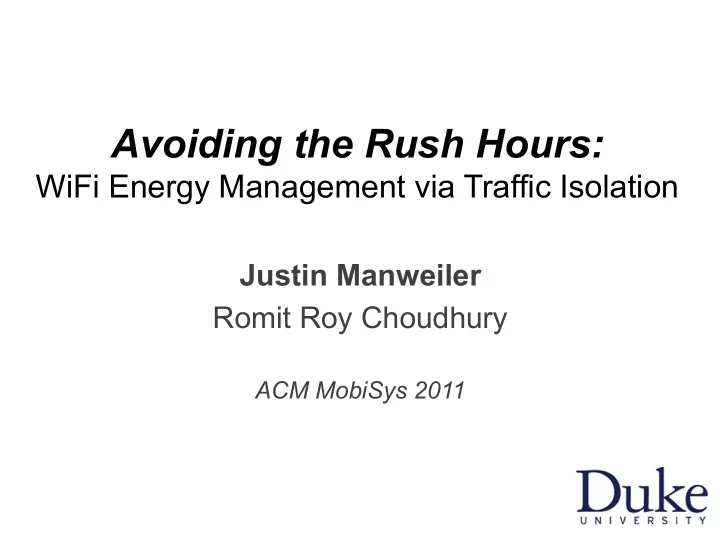

Avoiding the Rush Hours: WiFi Energy Management via Traffic Isolation Justin Manweiler Romit Roy Choudhury ACM MobiSys 2011
: Saving Energy through Sleep WiFi Between packet bursts, WiFi switches to low‐power sleep mode Zzz… Zzz… Time 2
WiFi Sleep Under Contention Zzz… Zzz… Time Zzz… Zzz… Time 3
Beacon Wakeups Bad wakeups = burst conten+on Traffic Download Key intui8on: move beacons , spread apart traffic, let clients sleep faster 4
Zzz… Zzz… vs MEASUREMENTS Energy performance on modern WiFi smartphones 5
Simultaneous measurements at 5K hertz 6
Energy Profile of Nexus One 700 600 Power (mW) 500 400 Idle/Overhear 300 200 100 Light Sleep 0 0.0 0.5 1.0 1.5 2.0 2.5 3.0 Time (s) Time (s) With conten*on: ↑ Idle/Overhear , ↓ Sleep 7
Energy Cost of Contention 40 Energy costs grow with Total Energy in Joules (J) 35 number of contenders 30 Iperf File Download 25 YouTube 20 15 10 5 0 1 AP 2 AP 3 AP 4 AP 5 AP 6 AP 7 AP 8 AP Denser Neighborhood 8
Activity Percentages File Download 100% 80% Increasing Ume in Idle/Overhear 60% Time High Power 40% Transmit/Receive Idle/Overhear Light Sleep 20% Deep Sleep 0% 1 AP 2 AP 3 AP 4 AP 5 AP 6 AP 7 AP 8 AP 9
Wakeup later / go home later Smarter commute = save gas Smarter beacons = save ba\ery SLEEPWELL DESIGN Avoiding the rush hours to save energy 10
SleepWell Techniques ● Traffic Monitoring APs maintain a map of peers in the wireless vicinity ● Traffic Migration APs select a new beacon posiUon based on heurisUcs ● Traffic Preemption APs avoid traffic spillover into that of neighbors 11
Traffic Monitoring beacon & traffic maps for the one‐hop neighborhood 12
Traffic Migration 0 85 Expected share = 100/( n + 1) = 25 ms 25 75 Claim expected share from largest hole 70 CONVERGES 55 55 50 13
Traffic Preemption 0 25 75 Traffic preemp+on prevents spillover 50 14
Key Implementation Challenge ● APs need to change the beacon timings ● But, no 802.11 protocol support 40 ● Fortunately, clients synchronize to AP clocks ● AP can change beacon by “lying” about the time Fully 802.11 compa+ble AP : Hostapd + modified Atheros Ath9k 802.11n driver 15
Rescheduling Client Wakeups “ hey client OK, I need to Right I’ll adjust I know client will Yes, delayed wakeup in 40ms my clock on +me wakeup in 40ms this beacon is client by 40ms 60ms Late” 0 0 Actual Client Clock Time (sync to AP) 50 50 16
Energy TDMA 800 800 800 SleepWell, 2 AP (Client A) 802.11, 2 AP SleepWell, 2 AP (Client B) Power (mW) Power (mW) Power (mW) 600 600 600 400 400 400 200 200 200 0 0 0 0.0 0.4 0.8 1.2 1.6 2.0 2.4 2.8 3.2 3.6 0.0 0.4 0.8 1.2 1.6 2.0 2.4 2.8 3.2 3.6 0.0 0.4 0.8 1.2 1.6 2.0 2.4 2.8 3.2 3.6 Time (s) Time (s) Time (s) 17
Energy Comparison 40 Total Energy in Joules (J) No ContenUon 35 802.11, 8 AP 30 SleepWell, 8 AP 25 20 15 10 5 0 Iperf YouTube Pandora File Download 18
Activity Percentages: 802.11 File Download 100% 80% 60% High Power 40% Transmit/Receive Idle/Overhear Light Sleep 20% Deep Sleep 0% 1 AP 2 AP 3 AP 4 AP 5 AP 6 AP 7 AP 8 AP 19
Activity Percentages: SleepWell File Download 100% 80% 60% High Power 40% Transmit/Receive Idle/Overhear Light Sleep 20% Deep Sleep 0% 1 AP 2 AP 3 AP 4 AP 5 AP 6 AP 7 AP 8 AP 20
Youtube CDF, Instantaneous Power 1 0.8 Empirical CDF SleepWell closely matches zero‐conten8on energy profile 0.6 0.4 1 AP 802.11, 8 AP 0.2 SleepWell, 8 AP 0 0 100 200 300 400 500 600 Power in Milliwa\s (mW) 21
Throughput under SleepWell (per-link TCP on 4 AP testbed) 1 Negligible performance impact: 0.8 SleepWell just reorders traffic Empirical CDF 0.6 0.4 802.11 0.2 SleepWell 0 0 0.5 1 1.5 2 2.5 Bandwidth (Mbps) 22
Limitations ● Not immediately suitable to interactive traffic (VoIP) True of 802.11 PSM in general ● Legacy APs lessen energy savings Won’t preempt for SleepWell traffic ● Contention from clients of the same AP Considered in NAPman [MobiSys 2010] 23
Prior Work ● WiFi PSM Sleep Optimization NAPman, Catnap [MobiSys 10] μPM [MobiSys 08] ● WiFi Duty Cycling Wake‐on‐Wireless [MobiCom 02] / revisited [MobiSys 07] Context‐for‐Wireless [MobiSys 07] Blue‐Fi [MobiSys 09], Breadcrumbs [MobiCom 08] Also, Turducken, Coolspots, Tailender, etc. ● Sensor network TDMA Z‐MAC [SenSys 05] S‐MAC [INFOCOM 02] 24
Conclusion to Zzz… Zzz… ● PSM is a valuable energy-saving optimization ● But, PSM designed with a single AP in mind ● Multiple APs induce contention, waste energy ● Staggered wakeups clients sleep through contention ● SleepWell = PSM made efficient for high-density networks 25
THANK YOU! Ques8ons? cs.duke.edu/~jgm jgm@cs.duke.edu 26
Recommend
More recommend